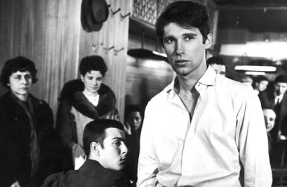
J. Hoberman counted Fire Music among the best films of 2021, but his capsule review sings a different tune: “Not a great documentary,” he begins, “but an effective reminder that…” Say no more. I find it almost touching that a hardcore cineaste like Hoberman should countenance such an ungainly film for the sake of “Cecil Taylor, Ornette Coleman, Albert Ayler, et al.” For music like that, anything. Still, we might ask of the film itself: why this lack of, well, fire? Director Tom Sturgal organizes his history like a Wikipedia entry, dutifully split between big names and rough chronology. In spite of some remarkable archival material—much of it from earlier films like Ron Mann’s Imagine the Sound (1981) and Robert Mugge’s Sun Ra: A Joyful Noise (1980)—the film is in such a hurry to cover ground that it never finds much of anything out. That a film about musicians who resisted and then reinvented structure should itself struggle to impose a unifying account on their art is an irony beyond its grasp.

Fire Music, it should be said, is hardly the worst offender in this increasingly crowded field. The fact that every musical artist with the slightest shred of mystique now seems to rate 90 minutes is the logical consequence of the music documentary being such a cinch for content, securing a built-in audience for streaming platforms and festivals hungry for a marquee guest. A handful of recent works show that interesting things can be done with the music documentary, but in most cases the film itself is a mere way station between fundraising pitch and think piece. This is a problem for documentaries more generally, but it hurts more when it’s music.
For fans, the allure of the music documentary lies in its promise of some unseen glimpse of a band in their prime, and with it a return to one’s first feelings for the music. Producers know this, trading on performance footage in trailers. But again and again in the finished films, this material is spoken over or otherwise abridged. Whatever they say, the music documentary gets jittery in the face of actual music. Perhaps it’s not so surprising: the most potent element of the movie—in some real sense its reason for being—is the one thing the filmmaker had no part in. Is it so hard to imagine this situation creating ambivalence, even anxiety? The film needs to do something, so it cuts.
I think of the heart-stopping footage of Nina Simone singing “Feelings” at the 1976 Montreux Jazz Festival. (2015) clearly grasps the gravity of the performance, allowing it to run for several minutes at a dramatic climax. But when it cuts, it does so with a sound bridge straight out of the VH1 playbook. In cutting directly to an interview in which Simone describes her money troubles, the performance is made to would be a very different kind of film—one arguably more in tune with its subject’s abandon.






